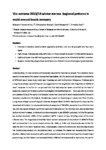The extreme 2013/14 winter storms: Regional patterns in multi-annual beach recovery
| dc.contributor.author | Konstantinou, A | |
| dc.contributor.author | Stokes, C | |
| dc.contributor.author | Masselink, Gerd | |
| dc.contributor.author | Scott, Tim | |
| dc.date.accessioned | 2021-08-09T11:18:36Z | |
| dc.date.available | 2021-08-09T11:18:36Z | |
| dc.date.issued | 2021-09-15 | |
| dc.identifier.issn | 0169-555X | |
| dc.identifier.issn | 1872-695X | |
| dc.identifier.other | 107828 | |
| dc.identifier.uri | http://hdl.handle.net/10026.1/17462 | |
| dc.description.abstract |
Understanding the mechanisms and timescales required for beaches to recover from extreme storm events is fundamental for coastal management worldwide. Yet the post-storm recovery characteristics of different beach types have rarely been investigated over multi-annual timescales. Previous work along the southwest coast of England has suggested that the magnitude and alongshore variability of beach response to storms can be grouped into four key response types controlled by the level of exposure, angle of storm wave approach and degree of embaymentisation. This study aims to enhance our understanding of the spatial and temporal patterns of post-storm beach recovery within this storm response classification framework. Analysis was based on morphological survey data from 23 sites along the southwest coast of England collected between 2012 and 2017. We found that beaches that responded similarly to the unprecedented storm sequence of 2013/14, recovered in a similar manner too, and that spatio-temporal patterns of post-storm recovery can, for the most part, also be described by four coherent classes. In terms of complete recovery to pre-2013/14 volumes, 7 of the 23 beaches we studied recovered >90% of their sediment within 3 years or less, including some of the most affected sites. The magnitude of intertidal beach volume recovered (in the order of 1-100m3m-1) was well correlated with the storm erosion volume (R = -0.81, p = 0.00) and, importantly, was similar for beaches within the same response class. Fully exposed, cross-shore dominated beaches experienced the highest gross erosion and recovery volumes, but showed the lowest net recovery after 3 years (median: 74% volume recovered), while semi-exposed cross-shore dominated beaches showed lower gross change, but the highest net recovery (median: 93% volume recovered).In most cases, the spatial pattern of recovery mirrored that of the storm impact, regardless of whether the beach was cross-shore or alongshore dominant. The observed coherency within each of the four studied beach response classes indicates that regional monitoring programmes could make considerable cost savings by strategically targeting monitoring at representative sites within each class, rather than monitoring all beaches within a region. | |
| dc.format.extent | 0-0 | |
| dc.language | en | |
| dc.language.iso | en | |
| dc.publisher | Elsevier BV | |
| dc.subject | Beach recovery | |
| dc.subject | Storm response | |
| dc.subject | LiDAR | |
| dc.subject | Beach classification | |
| dc.subject | Extreme storms | |
| dc.subject | Geomorphic change detection | |
| dc.subject | Coastal management | |
| dc.title | The extreme 2013/14 winter storms: Regional patterns in multi-annual beach recovery | |
| dc.type | journal-article | |
| dc.type | Journal Article | |
| plymouth.author-url | https://www.webofscience.com/api/gateway?GWVersion=2&SrcApp=PARTNER_APP&SrcAuth=LinksAMR&KeyUT=WOS:000685970700001&DestLinkType=FullRecord&DestApp=ALL_WOS&UsrCustomerID=11bb513d99f797142bcfeffcc58ea008 | |
| plymouth.volume | 389 | |
| plymouth.publication-status | Published | |
| plymouth.journal | Geomorphology | |
| dc.identifier.doi | 10.1016/j.geomorph.2021.107828 | |
| plymouth.organisational-group | /Plymouth | |
| plymouth.organisational-group | /Plymouth/Faculty of Science and Engineering | |
| plymouth.organisational-group | /Plymouth/Faculty of Science and Engineering/School of Biological and Marine Sciences | |
| plymouth.organisational-group | /Plymouth/REF 2021 Researchers by UoA | |
| plymouth.organisational-group | /Plymouth/REF 2021 Researchers by UoA/UoA07 Earth Systems and Environmental Sciences | |
| plymouth.organisational-group | /Plymouth/Research Groups | |
| plymouth.organisational-group | /Plymouth/Research Groups/Marine Institute | |
| plymouth.organisational-group | /Plymouth/Users by role | |
| plymouth.organisational-group | /Plymouth/Users by role/Academics | |
| plymouth.organisational-group | /Plymouth/Users by role/Researchers in ResearchFish submission | |
| dcterms.dateAccepted | 2021-06-06 | |
| dc.rights.embargodate | 2022-6-11 | |
| dc.identifier.eissn | 1872-695X | |
| dc.rights.embargoperiod | Not known | |
| rioxxterms.versionofrecord | 10.1016/j.geomorph.2021.107828 | |
| rioxxterms.licenseref.uri | http://www.rioxx.net/licenses/all-rights-reserved | |
| rioxxterms.licenseref.startdate | 2021-09-15 | |
| rioxxterms.type | Journal Article/Review |


